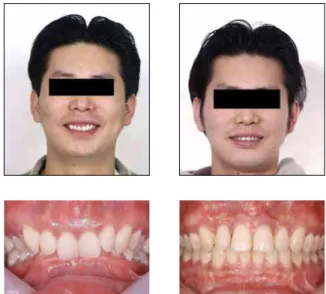ON L I N E AR T I C L E*
Dental Press J. Orthod. 42 v. 15, no. 2, p. 42-43, Mar./Apr. 2010
Orthodontic treatment of gummy smile by using
mini-implants (Part I): Treatment of vertical growth
of upper anterior dentoalveolar complex
Tae-Woo Kim**, Benedito Viana Freitas***
Orthodontic mini-implants have revolutionized orthodontic anchorage and biomechanics by making anchorage perfectly stable. In this Part I, ‘gummy smile’ was defined and clas-sified according to the etiologies. Among them, dentoalveolar type, a good indication of mini-implant treatment, was divided into three categories: (1) Cases with vertical growth of upper anterior dentoalveolar complex (Cases 1, 2, and 3), (2) Cases with protrusion of anterior dentoalveolar complex (Cases 4, and 5), and (3) Cases with protrusion of upper anterior dentoalveolar complex and extrusion of upper posterior teeth (Cases 6, and 7). Three cases with excessive vertical growth of the upper anterior dentoalveolar complex were presented. They were characterized with extruded and retroclined upper incisors, deep overbite, and gummy smile. The aim of this paper is to show that mini-implants are useful in the anterior area to intrude incisors and correct the gummy smile. An upper anterior mini-implant (1.6 x 6.0 mm) and a NiTi closed coil spring were used to intrude and procline the retroclined extruded incisors. Mini-implants can be used successfully as orthodontic anchorage to intrude anterior teeth.
Abstract
Keywords: Mini-implants. Intrusion. Gummy smile. Segmented arch.
** MSc and PhD in Orthodontics, National University of Seoul, South Korea. Associate Professor, National University of Seoul. *** PhD in Orthodontics, State University of Campinas (Unicamp). Assistant professor, Federal University of Maranhão.
Editor’s summary
The use of anchorage devices offers undeni-able benefits. No wonder it is so widespread among orthodontists. As well as reducing the reciprocal effects of orthodontic forces, mini-implants have opened new therapeutic avenues, such as the imple-mentation of tooth intrusion movements. Posterior
teeth intrusion may be indicated—primarily for prosthetic purposes—for teeth that have been ex-truded due to absent antagonists. Posterior region intrusion can still be performed to correct anterior open bite in patients with an essentially vertical facial pattern. Moreover, the intrusion of upper anterior teeth entails a rather precise indication.
Kim TW, Freitas BV
Dental Press J. Orthod. 43 v. 15, no. 2, p. 42-43, Mar./Apr. 2010 FIGURE 1 - Initial and final frontal view of the face; initial and final frontal
view of the occlusion.
FIGURE 2 - Initial and final frontal view of the face; initial and final frontal view of the occlusion.
It is recommended for the correction of deep over-bite in patients with overexposure of the gingiva in the anterior region only, during smiling, and prefer-ably if associated with retroclined upper incisors.
These morphological nuances are featured in three clinical cases illustrated in this article (Figs 1 and 2) and highlights an important clinical application of mini-implants in orthodontics.
Contact Address
Benedito Viana Freitas
Avenida da Universidade, quadra 2, número 27 – Cohafuma CEP: 65.070-650 – São Luís / MA, Brazil
E-mail: beneditovfreitas@uol.com.br
Questions
1) Are there any limitations on the use of mini-implants for upper anterior teeth intrusion?
The limitations are no different than in any other conventional intrusion technique. For ex-ample, patients with periodontal disease, root resorption, narrow interradicular space, etc. If a mini-implant is inserted into a too narrow space, intrusion will cause implant-root con-tact, which is bound to result in mini-implant failure. Should a mini-implant be inserted too low in order to expose its head it will cause the space left for spring insertion to become too narrow, thereby compromising the mechanics. Although no research has been hitherto con-ducted on the stability of anterior teeth intru-sion, it appears to be clinically better than pos-terior teeth extrusion.
2) What motivated you to write this article?
